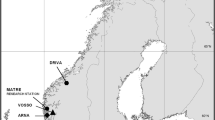Abstract
A doubled haploids (DH) population of 160 individuals is constructed by using mitotic gynogenetics for the study of genetic architectures of the body weight and morphological traits in Japanese flounder. Each DH individual is genotyped for 458 SSR markers, 222 of which segregate distortionally. By modifying conditional probabilities of quantitative trait locus (QTL) genotypes on the distorted flanking markers, Bayesian model selection is used to dissect genetic architectures for the traits. As a result, we identify 42 main-effect QTLs on chromosomes 5, 6, 7, 8, 9, 10, 15, 20, 21, 22, and 59 pairs of interacting QTLs. Among these detected QTLs, the largest interacting QTL is between chromosome 6 and chromosome 9 and accounts for 25.196 % of phenotypic variance for body weights and in a similar trend. Also, many QTLs show pleiotropic effects. The QTL on chromosome 9 simultaneously governs seven traits, BL, BH, FL, HL, PFL, HW, and CW. As compared to method using the uncorrected conditional probabilities of QTL genotypes, our method using corrected conditional probabilities can detect more interacting QTLs for the traits.



Similar content being viewed by others
References
Castaño-Sánchez C, Fuji K, Ozaki A, Hasegawa O, Sakamoto T, Morishima K, Nakayama I, Fujiwara A, Masaoka T, Okamoto H (2010) A second generation genetic linkage map of Japanese flounder (Paralichthys olivaceus). BMC Genomics 11:554
Cheng L, Liu L, Yu X, Wang D, Tong J (2010) A linkage map of common carp (Cyprinus carpio) based on AFLP and microsatellite markers. Anim Genet 41:191–198
Coimbra MR, Kobayashi K, Koretsugu S, Hasegawa O, Ohara E, Ozaki A, Sakamoto T, Naruse K, Okamoto N (2003) A genetic linkage map of the Japanese flounder, Paralichthys olivaceus. Aquaculture 220:203–218
Ds F, Tfc M (1996) Introduction to quantitative genetics, 4th edn. Longman, London
Fuji K, Kobayashi K, Hasegawa O, Coimbra MRM, Sakamoto T, Okamoto N (2006) Identification of a single major genetic locus controlling the resistance to lymphocystis disease in Japanese flounder (Paralichthys olivaceus). Aquaculture 254:203–210
Guo X, Li Q, Wang QZ, Kong LF (2012) Genetic mapping and QTL analysis of growth-related traits in the Pacific oyster. Mar Biotechnol 14:218–226
Hackett C, Broadfoot L (2003) Effects of genotyping errors, missing values and segregation distortion in molecular marker data on the construction of linkage maps. Heredity 90:33–38
Hu Z, Xu S (2009) PROC QTL—A SAS procedure for mapping quantitative trait loci. Int J Plant Genom 2009:1–3
Kang J-H, Kim W-J, Lee W-J (2008) Genetic linkage map of olive flounder, Paralichthys olivaceus. Int J Biol Sci 4:143
Kao C-H, Zeng Z-B (2002) Modeling epistasis of quantitative trait loci using Cockerham's model. Genetics 160:1243–1261
Kass RE, Raftery AE (1995) Bayes factors. J Am Stat Assoc 90:773–795
Lallias D, Lapegue S, Hecquet C, Boudry P, Beaumont A (2007) AFLP‐based genetic linkage maps of the blue mussel (Mytilus edulis). Anim Genet 38:340–349
Li L, Xiang J, Liu X, Zhang Y, Dong B, Zhang X (2005) Construction of AFLP-based genetic linkage map for Zhikong scallop, Chlamys farreri Jones et Preston and mapping of sex-linked markers. Aquaculture 245:63–73
Liao X, Ma H-Y, Xu G-B, Shao C-W, Tian Y-S, Ji X-S, Yang J-F, Chen S-L (2009) Construction of a genetic linkage map and mapping of a female-specific DNA marker in half-smooth tongue sole (Cynoglossus semilaevis). Mar Biotechnol 11:699–709
Liu Z, Karsi A, Li P, Cao D, Dunham R (2003) An AFLP-based genetic linkage map of channel catfish (Ictalurus punctatus) constructed by using an interspecific hybrid resource family. Genetics 165:687–694
Liu Y, Liu Y, Liu Y, Zhang X, Si F, Sun Z, Wang G, Wang Y, Yang R, Liu H (2013) Constructing a genetic linkage map and mapping quantitative trait loci for skeletal traits in Japanese flounder. Biologia 68:1221–1228
Lorieux M, Goffinet B, Perrier X, De Leon DG, Lanaud C (1995) Maximum-likelihood models for mapping genetic markers showing segregation distortion. 1. Backcross populations. Theor Appl Genet 90:73–80
Song W, Pang R, Niu Y, Gao F, Zhao Y, Zhang J, Sun J, Shao C, Liao X, Wang L (2012) Construction of high-density genetic linkage maps and mapping of growth-related quantitative trail loci in the Japanese flounder (Paralichthys olivaceus). PLoS One 7:e50404
Song W, Miao G, Zhao Y, Niu Y, Pang R, Liao X, Shao C, Chen S (2013) Construction of a microsatellite-based genetic linkage map for half-smooth tongue sole Cynoglossus semilaevis. Zoology 59:1
Xu S (1998) Iteratively reweighted least squares mapping of quantitative trait loci. Behav Genet 28:341–355
Xu S (2008) Quantitative trait locus mapping can benefit from segregation distortion. Genetics 180:2201–2208
Yamamoto E (1999) Studies on sex-manipulation and production of cloned populations in hirame, Paralichthys olivaceus (Temminck et Schlegel). Aquaculture 173:235–246
Yandell BS, Mehta T, Banerjee S, Shriner D, Venkataraman R, Moon JY, Neely WW, Wu H, Von Smith R, Yi N (2007) R/qtlbim: QTL with Bayesian interval mapping in experimental crosses. Bioinformatics 23:641–643
Yi N, Yandell BS, Churchill GA, Allison DB, Eisen EJ, Pomp D (2005) Bayesian model selection for genome-wide epistatic quantitative trait loci analysis. Genetics 170:1333–1344
Yi N, Shriner D, Banerjee S, Mehta T, Pomp D, Yandell BS (2007) An efficient Bayesian model selection approach for interacting quantitative trait loci models with many effects. Genetics 176:1865–1877
Acknowledgments
This work was financially supported by Special Scientific Research Funds for Central Non-profit Institutes, Chinese Academy of Fishery Sciences (2014B004 and 2014A04XK01) and the National Natural Science Foundations of China (30972077 and 31172190).
Author information
Authors and Affiliations
Corresponding author
Rights and permissions
About this article
Cite this article
Cui, Y., Wang, H., Qiu, X. et al. Bayesian Analysis for Genetic Architectures of Body Weights and Morphological Traits Using Distorted Markers in Japanese Flounder Paralichthys olivaceus . Mar Biotechnol 17, 693–702 (2015). https://doi.org/10.1007/s10126-015-9646-8
Received:
Accepted:
Published:
Issue Date:
DOI: https://doi.org/10.1007/s10126-015-9646-8




